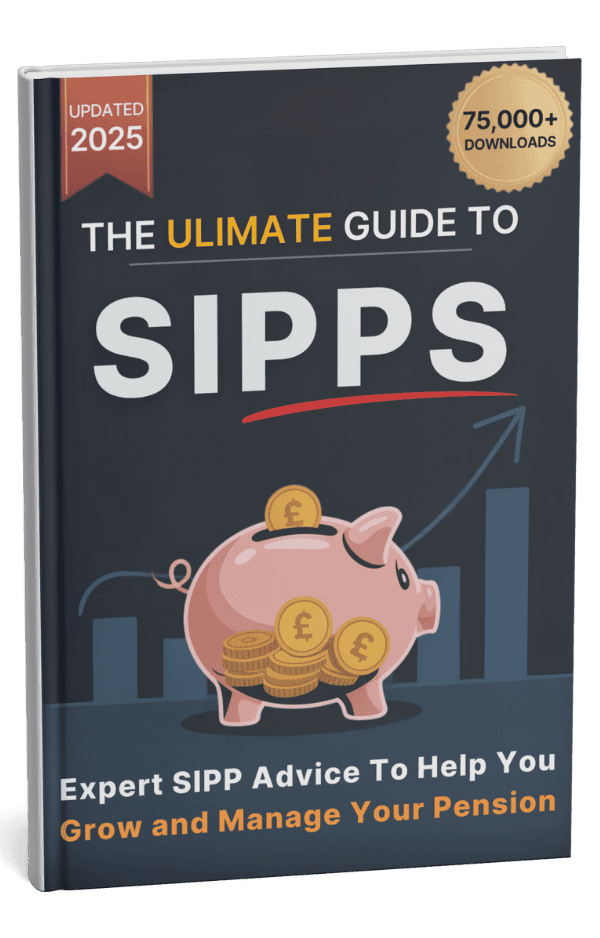
Best SIPPs for the Self-Employed in 2025: Top 7 Options to Consider
See How Much Your Future Pension Income Could Be In Just 60 Seconds — No Fees, No Obligation.
How Much Could You Unlock?
Why Homeowners Trust Us
Try Our Free Pension Calculator
Quick, Safe Estimate

No Commitments
Key Takeaways
- The ideal SIPP for self-employed investors combines flexibility with low fees, with top choices including AJ Bell, Bestinvest, and Hargreaves Lansdown.
- Look for a range of investment choices, reasonable fees, robust customer support, and strong online functionality.
Finding the best SIPP for the self-employed could make a big difference to your financial planning, especially considering that, according to a 2022 Parliamentary report, only about 16% of this demographic are actively saving for retirement.1
This lack of retirement planning is alarming yet understandable given the complex financial landscapes that self-employed professionals navigate.
Self-Invested Personal Pensions (SIPPs) offer a level of flexibility, control over investments, and tax efficiency that make them particularly well suited to you if you are your own boss.
In This Article, You Will Discover:
To help you make an informed decision, EveryInvestor has meticulously researched the ins and outs of the subject to bring you accurate and up-to-date information on the best SIPP for the self-employed.
What Is a SIPP?
In the UK, a Self-Invested Personal Pension (SIPP) presents a customisable approach to retirement planning, empowering savers to manage and choose their own pension investments.
These products allow investors to incorporate a variety of assets, such as equities, bonds, collective investments, and commercial real estate, into their retirement strategy.
They are designed to align with your personal financial aspirations and risk capacity, offering a bespoke portfolio management experience.
Why Consider a SIPP If You Are Self-Employed?
If you are self-employed, you may consider a SIPP because it offers the option of making flexible contributions, which may suit those earning an unpredictable income.

Additionally, SIPPs provide investment autonomy and diverse options aligned to your risk preferences.
The potential for tax relief may also result in significant savings.
Remember
Investments are inherently risky and the value of your SIPP may decrease as well as increase over time.
Which Are the Best SIPPs for the Self-Employed?
The best SIPPs for the self-employed should offer varying levels of investment flexibility and support.
Assessing the features and pros and cons of these options will help you make an informed decision tailored to your situation.
In this section, we take a look at seven SIPPs suited to self-employed investors.

PensionBee
PensionBee offers eight pension plans, each tailored to particular needs.2
While PensionBee does not offer a SIPP, its curated pension plans may be worth considering if you are less confident when it comes to managing your investments.
The firm’s website actively encourages the self-employed to consider consolidating old pensions or start a new one.3
What Are the Benefits of a PensionBee Plan?
The benefits of a PensionBee plan include the option of making flexible contributions.
Pros include:
- Assists with pension consolidation into one manageable account.
- Contributions are flexible to accommodate fluctuations in your income.
- One annual fee ranging from 0,50% to 0,95% depending on your chosen plan with 50% off on the portion of your pension over £100k.4
What Are the Disadvantages of a PensionBee Plan?
The disadvantages of a PensionBee plan include a lack of advice.
Cons include:
- Predefined plans may not suit those seeking highly personalised options.
- No financial advice.
Nutmeg
Nutmeg, an established robo-advisory firm, caters to individuals seeking simplified automated investing with diverse portfolio choices with a minimum initial investment of £500.5
Does Nutmeg offer SIPPs?
No, Nutmeg's plans are not SIPPs, but we have decided to include them here anyway, as they may be of interest to self-employed investors exploring their pension options.
Nutmeg offers four ‘investment styles’: Fully Managed, Fixed Allocation, Smart Alpha, and Socially Responsible.
What Are the Benefits of a Nutmeg Plan?
The benefits of a Nutmeg plan include having access to an award-winning investment platform.6
Pros include:
- Access to free financial guidance.
- Access to educational materials and goal-planning tools.
- Easy-to-use app and desktop platforms.
What Are the Disadvantages of a Nutmeg Plan?
The disadvantages of a Nutmeg plan include the relatively higher costs involved.7
Cons include:
- Offers only a drawdown service for retirement; not suitable for those seeking annuities.
- Socially conscious investors might have concerns about the company's ownership by JP Morgan, an organisation that is still separating itself from investments in fossil fuels.8
AJ Bell
AJ Bell’s offering is a traditional SIPP with comprehensive investment options and user-friendly tools, including a mobile app.
The cost of holding your investments is 0,25% on the first £250,000, 0,10% on the next £250,000, and no charge on the portion over £500,000 (if applicable).9
What Are the Benefits of an AJ Bell Plan?
The benefits of an AJ Bell plan include the use of the firm's investment platform, which allows users to filter products according to Morningstar's ratings.10
Pros include:
- This SIPP allows access to an extensive array of shares, funds, and investment choices, offering flexibility in crafting your portfolio.
- You can contribute from as little as £25 per month to a maximum of 100% of your annual earnings.11
- The online platform is intuitive and easy to navigate, allowing for straightforward portfolio management.
What Are the Drawbacks of an AJ Bell Plan?
The drawbacks of an AJ Bell plan may include the time and effort it can take to look after your investments by yourself.
Cons include:
- This is not a robo-advisor SIPP, so as a self-employed person, you may find it difficult to find the time to manage your SIPP investments.
- Opting for a financial advisor can incur additional costs.
- Trading shares costs £9,95 each, which can render the endeavour quite a pricey one, but this charge drops to £4,95 if you performed more than 10 transactions the previous month.12
Penfold
The Penfold SIPP was originally designed with the self-employed in mind, with four investment options available.
These options are Standard, Lifetime, Shariah, and Sustainable.
This provider offers an all-in-one fee structure:
- on the standard plans, the charge is 0,75% on savings up to £100,000 and 0,4% on the portion exceeding £100,000.
- on the Sharia plan, the rate is 0,88% for portfolios up to £100,000 and 0,53% on the portion beyond that.13
What Are the Benefits of a Penfold Plan?
The benefits of a Penfold plan include the fact that it comes with one transparent fee.
Pros include:
- Highly flexible contributions make it easy to adapt your savings to your fluctuating income.
- The all-in-one fee structure simplifies costs by combining admin and fund manager charges.
- The 'Explore your pension' feature offers transparency in fund allocation.
What Are the Drawbacks of a Penfold Plan?
The drawbacks of a Penfold plan may include not having access to financial advice.
Cons include:
- Some funds are managed by BlackRock, whose fossil fuel investment may not meet some investors’ sustainability objectives.14
- Penfold does not offer financial advice, making it less ideal for those new to pension planning.
- Being low-cost may mean a relatively limited range of investment options.
Bestinvest
Bestinvest’s Best SIPP comes with low fees and a broad range of investment options, which may appeal to the self-employed.
On the firm’s ready-made plans, charges are:
- 0,2% on investments up to £500,000
- 0,1% on the portion between £500,000 and £1 million
- no fee on the portion over £1 million.15
What Are the Benefits of a Bestinvest Plan?
The benefits of a Bestinvest plan include low platform fees.
Pros include:
- Free individual coaching is available to enhance your investing skills.
- The firm will pay up to £500 towards your exit fees when you transfer at least £50,000 to your new Bestinvest SIPP.16
- Low platform fees on ready-made plans and no trading fees on US shares.17
What Are the Drawbacks of a Bestinvest Plan?
The drawbacks of a Bestinvest plan include the fact that investors are limited to UK and US stocks.
Cons include:
- Limited range of stocks, restricting global diversification.18
- Relatively high platform charges on self-invested portfolios.19
- Relatively high foreign exchange fees.
Hargreaves Lansdown
The Hargreaves Lansdown SIPP offers a flexible retirement saving solution for self-employed individuals.
The annual admin fee starts at 0,45% and decreases to 0% for the portion of your portfolio over £2 million.20
What Are the Benefits of a Hargreaves Lansdown Plan?
The benefits of a Hargreaves Lansdown plan include access to the online platform, which allows users to find information on funds.21
Pros include:
- There are more than 2,500 investment options to choose from.
- 24/7 access to your account through a user-friendly online platform and app.
- Buying and selling funds is free.
What Are the Drawbacks of a Hargreaves Lansdown Plan?
The drawbacks of a Hargreaves Lansdown plan include the fact that investors are not able to use the platform the filter funds according to sustainability.22
Cons include:
- Admin charges can be expensive for smaller pension pots.
- Buying and selling shares can be costly.
- Financial advice comes at an extra cost.
Moneyfarm
The Moneyfarm robo-advisory personal pension is not a true SIPP as it only offers exchange-traded funds in ready-made portfolios.
It does, however, offer the same tax relief as a SIPP.
What Are the Benefits of a Moneyfarm Plan?
The benefits of a Moneyfarm plan include access to its easy-to-use platform.
Pros include:
- A personal investment consultant is available to offer free financial advice on choosing your portfolio.
- One inclusive management fee based on a percentage of your investments starting at 0,75% for your first £10,000.23
- A user-friendly, intuitive app.
What Are the Drawbacks of a Moneyfarm Plan?
The drawbacks of a Moneyfarm plan include a lack of income portfolio for drawdown purposes.24
Cons include:
- The platform only offers exchange-traded funds (ETFs), which may not be suitable for those looking for a broader range of investment options.
- A minimum investment of £500 could be a barrier for self-employed individuals.
- The tiered fee structure may be high for smaller pension pots.
What Criteria Did We Use to Choose the Best SIPPs for the Self-Employed?
Our criteria for choosing the best SIPPs for the self-employed focused on a balanced evaluation of fees and charges, the range of investment options and flexibility, and the account features designed to support individual financial goals.

How Do You Choose the Best SIPP If You Are Self-Employed?
To choose the best SIPP if you are self-employed, it is essential to consider several key factors tailored to your individual financial situation, investment knowledge, and retirement goals.
Here is a step-by-step guide to help you make an informed decision:
- Understand Your Retirement Needs: Start by estimating the income you will need in retirement. Consider your lifestyle, expected living costs, and any other income sources you might have in retirement, like state pensions or other savings.
- Assess Your Investment Knowledge: SIPPs offer a wide range of investment choices, including stocks, bonds, and funds. If you are confident in making investment decisions, a SIPP can be a good way to take control of your retirement savings. If not, you might prefer a SIPP provider that offers advice or pre-selected investment portfolios.
- Compare Fees and Charges: SIPPs come with various fees, including set-up charges, annual management fees, and transaction fees. Ensure you understand the fee structure as it can significantly impact your investment returns over time.
- Check Investment Options: Ensure the SIPP provides a wide range of investment options that suit your investment strategy and risk tolerance. Some SIPPs offer access to international markets, ethical investments, or commercial property.
- Consider Flexibility and Access: Think about how often you want to contribute and whether you might need to vary your contributions. Some SIPPs allow flexible contributions, which can be beneficial if your self-employed income fluctuates.
- Read Reviews and Ask for Recommendations: Look for customer reviews and ratings of different SIPP providers. You can also ask for recommendations from fellow self-employed individuals or financial advisors.
- Get Professional Advice: If you are unsure, consider seeking advice from a financial advisor. They can provide personalised advice based on your financial situation and help you navigate the complex landscape of pensions and investments.
By carefully considering these factors, you can choose a SIPP that aligns with your financial goals and provides a solid foundation for your retirement.
Remember, the best SIPP for you is one that fits your individual needs, offers flexibility, and maximises your retirement savings in a cost-effective way.
What Are the Alternatives to SIPPs for Self-Employed People?
Alternatives to SIPPs for self-employed people include standard personal pensions, stakeholder pensions, and NEST pensions, each with its own set of features, benefits, and limitations.

Standard Personal Pension
A standard personal pension is a more traditional retirement savings product that typically offers a narrower range of investment options than a SIPP.
Managed by pension companies, these plans often come with a predetermined set of funds you can invest in.
Stakeholder Pension
Stakeholder pensions are designed to be simple and low cost, making them accessible to people with varying levels of income and financial knowledge.
With this type of plan, your contributions are invested on your behalf by a bank, building society, insurance company or trade union, making them a potentially good fit for those who prefer not to be hands on when it comes to managing their pension.
These retirement plans are required to adhere to governmental guidelines concerning fees and terms and conditions.
NEST Pension
The National Employment Savings Trust (NEST), initiated by the UK government as an employment-based pension scheme, is also available to self-employed pension savers.
With its simple yet limited array of investment choices and low fees, the NEST serves as a practical choice for those in search of an uncomplicated, affordable retirement plan.
Common Questions
Yes, a SIPP can be beneficial for self-employed individuals thanks to the flexible contribution structures of some plans, meaning your potentially irregular income will not prohibit you from planning for your future.
Alternatives include Standard Personal Pensions, Stakeholder Pensions, and NEST Pensions, each with varying features and benefits.
Self-employed individuals are not legally required to have a private pension, but it is strongly advised for financial security in retirement.
Without employer contributions, setting up a private pension like a SIPP can help build retirement savings, with tax benefits enhancing contributions.
The State Pension often falls short in providing a comfortable retirement, making private pensions a crucial supplement for long-term financial stability.
Self-employed individuals can contribute up to their annual earnings or £60,000 per year into a SIPP and receive tax relief on contributions.21
Yes, self-employed individuals receive tax relief on contributions to a SIPP, as well as tax-free growth on investments and the option to take out a 25% untaxed lump sum upon retirement.
The best SIPP for the self-employed is one that offers:
- Low fees: To maximize retirement savings.
- Flexible contributions: Allowing for changes in income.
- Wide range of investment options: Catering to different risk appetites and investment strategies.
- Online access and management tools: For ease of managing investments.
Providers such as Hargreaves Lansdown, AJ Bell, and Youinvest are often highlighted for their comprehensive offerings that suit a wide range of investment preferences and provide a good balance of cost, flexibility, and support.
Self-employed individuals should consider:
- Fees and charges: Understanding all associated costs, including annual management charges and transaction fees.
- Investment choice: Ensuring a broad array of options is available, from stocks and shares to funds and bonds.
- Flexibility: The ability to adjust contributions according to financial circumstances without penalty.
- Ease of use: A user-friendly platform that allows for straightforward management of investments.
- Support and advice: Access to advice and investment research can be invaluable, especially for those new to investing.
Yes, some special features beneficial for the self-employed include:
- Contribution flexibility: Given the fluctuating income common in self-employment, being able to vary contributions without charges is crucial.
- Wide investment selection: To tailor investment strategy to individual risk tolerance and goals.
- Consolidation options: The ability to consolidate previous pensions into one SIPP for simplicity and better control.
- Drawdown flexibility: Offering various options for accessing the pension pot, reflecting the diverse needs at retirement.
Absolutely, SIPPs offer significant tax advantages, which include:
- Tax relief on contributions: Claim back 20% automatically added to contributions for basic rate taxpayers, with higher and additional-rate taxpayers able to claim further relief through their tax return.
- Tax-free growth: Investments within a SIPP grow free from Income and Capital Gains Tax.
- 25% tax-free lump sum: At age 55 (57 from 2028), up to 25% of the pension pot can be withdrawn tax-free, with the remainder being subject to income tax at the individual’s marginal rate when drawn down.
In Conclusion
Choosing the right retirement plan is an essential component of financial security, particularly for those who do not have the benefit of an employer-sponsored pension.
The flexibility, investment control, and tax advantages of a SIPP make it an attractive option for freelancers, entrepreneurs, and other self-employed individuals.
By diligently researching and comparing the various offerings, you can find a SIPP that aligns with both your financial goals and your work lifestyle.
Ultimately, the best SIPP for the self-employed is one that allows for maximum potential growth while also providing a level of contribution flexibility that would benefit those who may not receive a regular income.

Found an Error? Please report it here.






 100% private. No pressure. Just friendly guidance.
100% private. No pressure. Just friendly guidance.


